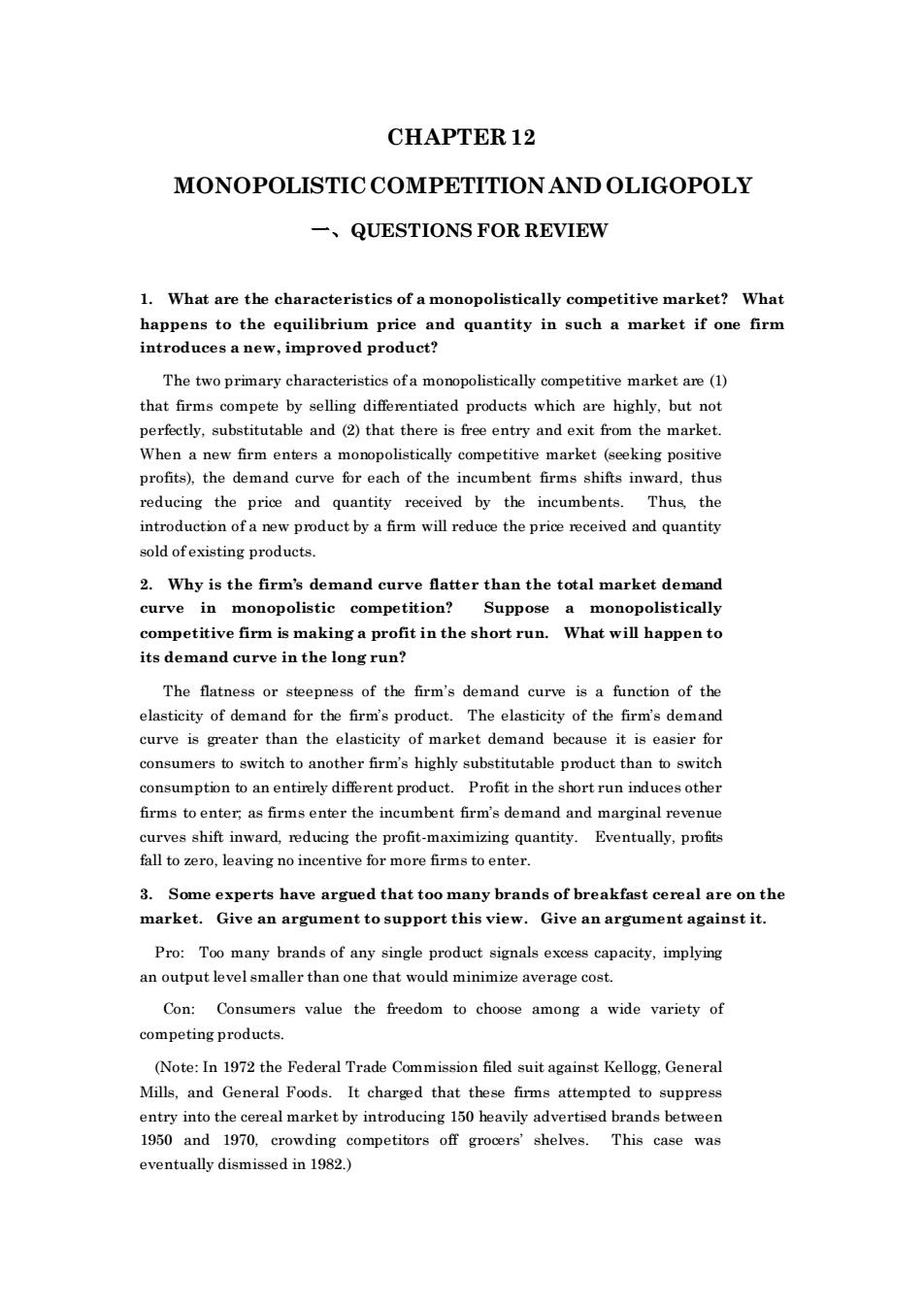正在加载图片...

CHAPTER 12 MONOPOLISTIC COMPETITION AND OLIGOPOLY 一、QUESTIONS FOR REVIEW 1.What are the characteristics of a monopolistically competitive market?What happens to the equilibrium price and quantity in such a market if one firm introduces a new,improved product? The two primary characteristics ofa monopolistically competitive marketare(1) that firm compete differntiated products which are highly,but not perfectly,substitutable and (2)that there is free entry and exit from the market. When a new firm enters a monopolistically competitive market (seeking positive profits),the demand curve for each of the incumbent firms shifts inward,thus reducing the price and quantity received by the incumbents.Thus the introduction of a new product by a firm will reduce the price received and quantity od ofexistin products. 2.Why is the firm's demand curve flatter than the total market demand curve in monopolistic competition? Suppose a monopolistically competitive firm is making a profit in the short run.What will happen to its demand curve in the long run? be firm's pro oduct The of the fi curve is greater than the elasticity of market demand because it is easier fo consumers to switch to another firm's highly substitutable product than to switch consumption to an entirely different product.Profit in the short run induces other Grms to enter as firms enter the incumbent firm's demand and marginal revenue the profit-maximizing quantity .leaving no incentive for morefm Eventually,pr Some experts have argued that too many brands of breakfast cereal are on the market.Give an argument to support this view.Give an argument against it. Pro:Too many brands of any single product signals excess capacity,implying an output level smaller than one that would minimize average cost. Con:Consumers value the freedom to choose among a wide variety of competing products. (Note:In 1972 the Federal Trade Commission filed suit against Kellogg,General Mills,and General Foods.It that these firms attempted tos ppress entry into the ce real market by introducing 150 heavily advertised brands between 1950 and 1970.crowding competitors off grooers'shelves. This case was eventually dismissed in 1982.)CHAPTER 12 MONOPOLISTIC COMPETITION AND OLIGOPOLY 一、QUESTIONS FOR REVIEW 1. What are the characteristics of a monopolistically competitive market? What happens to the equilibrium price and quantity in such a market if one firm introduces a new, improved product? The two primary characteristics of a monopolistically competitive market are (1) that firms compete by selling differentiated products which are highly, but not perfectly, substitutable and (2) that there is free entry and exit from the market. When a new firm enters a monopolistically competitive market (seeking positive profits), the demand curve for each of the incumbent firms shifts inward, thus reducing the price and quantity received by the incumbents. Thus, the introduction of a new product by a firm will reduce the price received and quantity sold of existing products. 2. Why is the firm’s demand curve flatter than the total market demand curve in monopolistic competition? Suppose a monopolistically competitive firm is making a profit in the short run. What will happen to its demand curve in the long run? The flatness or steepness of the firm’s demand curve is a function of the elasticity of demand for the firm’s product. The elasticity of the firm’s demand curve is greater than the elasticity of market demand because it is easier for consumers to switch to another firm’s highly substitutable product than to switch consumption to an entirely different product. Profit in the short run induces other firms to enter; as firms enter the incumbent firm’s demand and marginal revenue curves shift inward, reducing the profit-maximizing quantity. Eventually, profits fall to zero, leaving no incentive for more firms to enter. 3. Some experts have argued that too many brands of breakfast cereal are on the market. Give an argument to support this view. Give an argument against it. Pro: Too many brands of any single product signals excess capacity, implying an output level smaller than one that would minimize average cost. Con: Consumers value the freedom to choose among a wide variety of competing products. (Note: In 1972 the Federal Trade Commission filed suit against Kellogg, General Mills, and General Foods. It charged that these firms attempted to suppress entry into the cereal market by introducing 150 heavily advertised brands between 1950 and 1970, crowding competitors off grocers’ shelves. This case was eventually dismissed in 1982.)